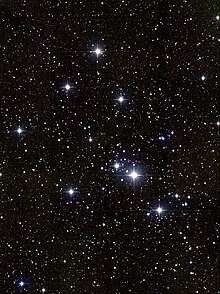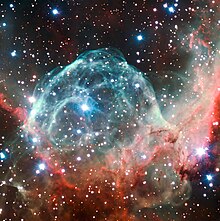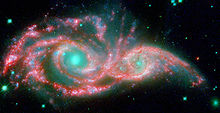Canis major
The Canis Major (Canis Maior) is a constellation that seems to follow, in its course in the sky due to the movement of the day, the "Great Hunter", Orion.
Notable features
Sirius (α Canis Majoris) is the brightest star in the night sky and also one of the closest, since it is 8.6 light years from Earth; it is a binary star composed of Sirius A, the star visible to the naked eye, and Sirius B, a white dwarf. Sirius A is a white star of the main sequence of type A0 or A1, 25 times more luminous than the Sun. orbital is 50.1 years.
Adhara (ε Canis Majoris) is the second brightest star in Canis Major; also a binary, its main component is a blue supergiant or luminous giant of 22,900 K temperature with a luminosity equivalent to 20,800 times that of the Sun or 820 times that of Sirius. They are followed in brightness by δ Canis Majoris, known as Wezen, a supergiant of spectral type F8Ia which, with a mass of 17 solar masses, will end its life exploding in the form of a supernova; it is, therefore, one of the most massive stars that can be seen with the naked eye.
Murzim or Mirzam (β Canis Majoris) is also a massive bluish-white giant or subgiant and one of the main representatives of the Beta Cephei variables. Murzim's closest approach to the system occurred 4.36 million years ago solar: distant then only 35 light-years, its brightness reached apparent magnitude -3.78, making it much brighter than Sirius today. η Canis Majoris, called Aludra, is an extraordinarily luminous type B5Ia blue supergiant, approximately 150,000 times brighter than the Sun; it is also a Deneb-like Alpha Cygni variable (α Cygni). ζ Canis Majoris, officially called Furud, is a hot star with a temperature of 18,700 K and spectral type B2.5V; it is also a spectroscopic binary with an orbital period of 675 days.
The constellation's best-known variable is VY Canis Majoris, a red hypergiant of enormous size, with a radius that may be 1420 times that of the Sun, equivalent to 6.6 au: if it were in the center of the solar system, its surface would extend beyond the orbit of Jupiter. It is one of the largest known stars and one of the most massive.
Another variable of interest is Z Canis Majoris, a binary system resolved by speckle interferometry consisting of two very young stars only 50,000 years old. One of the components is a 12 solar mass Herbig Ae/Be star and the other is a FU Orionis star. Both objects are surrounded by active accretion disks and, associated with the binary system, a giant "jet" the size of a parsec has been observed. In 2008 the system experienced the largest outburst in the last 90 years.
There are several stars in the constellation that have planetary systems. ν2 Canis Majoris is an orange giant with two planets orbiting at 1.77 and 2.14 AU from the star. Another giant with a planet—with at least four times the mass of Jupiter—is HD 47536. Likewise, HD 45184 is a solar analogue of type G2V with two planets, 12 times and 8.8 times more massive than Earth.
Among the deep space objects is the open cluster M 41. It has a diameter of 25 - 26 light years, with an estimated age between 190 and 240 million years. It was discovered by Giovanni Batista Hodierna before 1654 and independently rediscovered by Guillaume Le Gentil in 1749; it was perhaps also known to Aristotle around 325 B.C. C. Another open cluster is NGC 2362, distant 5,400 light-years from the Sun. τ Canis Majoris is its brightest member, a blue supergiant of the rare spectral type O that is part of a massive star system of at least five components.
NGC 2359, known as the Thor's Helmet Nebula, is an emission nebula whose central star, WR 7, is a distant Wolf-Rayet star of type WN4. Assuming a distance of 15,600 light-years, is estimated to be 280,000 times more luminous than the Sun and 16 times more massive. It is a very hot star with an effective temperature of about 112,000 K.
In 2003 the discovery of the Canis Major Dwarf galaxy was announced, whose distance from Earth—25,000 light-years—made it the closest galaxy to the Milky Way. However, subsequent studies have questioned whether it really is a galaxy. Thus, this "overdensity" only contains ten RR Lyrae variables, which is consistent with it being part of the halo and population of the Milky Way's thick disk, rather than a distinct dwarf spheroidal galaxy.
Main Stars
- α Canis Majoris (Syrian), the brightest star seen from Earth with magnitude -1,46. It is orbited, with a period of 50 years, by a white dwarf named Sirio B first observed by Alvan Clark.
- β Canis Majoris (Murzim or Mirzam), with magnitude 1,98 is a giant blue and variable star of the Beta Cephei type.
- γ Canis Majoris (Muliphein), of magnitude 4,11, is a star of mercury-manganese calls.
- δ Canis Majoris (Wezen), the third most brilliant constellation with magnitude 1.83, is a supergiant yellow star, one of the largest among the observable in the naked eye.
- ε Canis Majoris (Adhara), double star whose components are separated 7 seconds of arc.
- ج Canis Majoris (Furud), spectroscopic binary of magnitude 3,02 and white-blue.
- η Canis Majoris (Aludra), of magnitude 2.45, a blue supergigante as luminous as 66,000 soles and variable of Alpha Cygni type.
- θ Canis Majoris, orange giant of magnitude 4,09.
- ι Canis Majoris, supergigante blue 46,000 times brighter than the Sun.
- κ Canis Majoris, Star Be of magnitude 3.51.
- μ Canis Majoris, fixed binary star whose two components are separated 3 seconds of arc.
- . Canis Majoris designates three different stars; ν2 Canis Majoris, 65 light years old, is an orange subgiant with two planets.
- roga Canis Majoris, the name of Bayer shared by two different stars: φ1 Canis Majoris, the brightest, a blue subgigante, and φ2 Canis Majoris, a white giant of magnitude 4,53.
- ο Canis Majoris, also two different stars: ο1 Canis Majoris, the least brilliant, an orange supergigante, and ο2 Canis Majoris, a blue supergigante of magnitude 3.02.
- π Canis Majoris, star with an excess in the infrared that indicates the presence of a circumestelar disk of dust.
- σ Canis Majoris, red supergigante and irregular variable, whose brightness varies between magnitude 3.43 and 3.51.
- τ Canis Majoris, supergigante of the rare spectral type O, the brightest NGC 2362 cluster.
- ω Canis Majoris, blue star and eruptive variable Gamma Cassiopeiae, with a variation of brightness between magnitude 3,6 and 4,18.
- 12 Canis Majoris (HK Canis Majoris), a peculiar star of average magnitude 6.08.
- 15 Canis Majoris (EY Canis Majoris), white-azulada supergigante of magnitude 4,81 and Beta Cephei variable.
- 26 Canis Majoris (MM Canis Majoris), an average Bp star 5.90.
- 27 Canis Majoris (EW Canis Majoris), triple star system where one of the stars is a Gamma Cassiopeiae variable.
- R Canis Majoris, nearby binary star and ellipsing binary of magnitude 5.71.
- Z Canis Majoris, binary system composed of a Herbig Ae/Be star and a FU Orionis star.
- SW Canis Majoris, binaria eclipsante of magnitude 9,15.
- VY Canis Majoris, one of the greatest known hypergiant stars and one of the most luminous.
- FR Canis Majoris and FW Canis Majoris, both Be stars and Gamma Cassiopeiae variables.
- EZ Canis Majoris, star Wolf-Rayet.
- FZ Canis Majoris, triple system of magnitude 8.14.
- NR Canis Majoris, Delta Scuti variable of magnitude 5.62.
- HD 45184, solar analog of magnitude 6,37 distant 72 light years.
- HD 47536 (HR 2447), giant orange star with two extra-solar planets.
Deep Sky Objects
- M 41 (NGC 2287). AR: 06h 46m 00.0s Dec: -20°44'00" (Epoca 2000). Open cluster of about 80 bright stars to 4 or south of Sirio, visible at the naked eye.
- NGC 2362. AR: 07h 18m 48.0s Dec: -24°57'00" (Epoca 2000). Open cluster composed of about 60 stars; it is appreciated as a nebulosity around the brightest of them, τ Canis Majoris. It is estimated at 4 to 5 million years.
- NGC 2359, known as Thor's Helmet nebula, is an emission nebula illuminated by the star of Wolf-Rayet WR 7 (HD 56925). His form recalls the helmet of a warrior.
- NGC 2280, the brightest galaxy of the constellation, a coiled spiral located 3rd to the northwest of Adhara (ε Canis Majoris).
- NGC 2217, a coiled spiral galaxy that is 3rd in the north of Furud.
- NGC 2207, another spiral galaxy of magnitude 10.8 located at 3.5° southwest of Murzim (β Canis Majoris).
- IC 2163, Interacting with NGC 2207.
- Galaxia Enana del Can Mayor, whose nature as a galaxy has been questioned.
Mythology
There are various identifications that have been proposed for the Canis Major:
- Lélape, a dog that was given by Zeus to Europe, who passed to several later generations until he became the dog of Céfalo. During the persecution of the Teumeian bitch, he was converted by Zeus into stone and then placed among the constellations.
- The dog of Orion, who was placed in heaven at the same time as his master, since he had always been with him.
- Mera, from Icario and Erígone. He found the lifeless bodies of his masters and with their laments he attracted people to be buried. Dionysus put it between the constellations.
The star Sirius, whose name means "scorching" and also known as "the dog star," is the brightest star in the night sky, second only in apparent brightness to the Moon and the planets Venus, Jupiter, and Mars. Because it is invisible during the boreal summer, it was formerly thought that its energy added to that of the Sun to produce the hottest days or "dog days" ("canicular days").
Contenido relacionado
Absolute magnitude
Helvetios (star)
Laika






